From readers: “Our Place said their Always Pan is Lead-free. They sent me test results. Tamara, can you explain?”
Please read the full article below the linked report from the manufacturer.
December 11, 2020 — Friday
In response to the original article I wrote, with the results for the XRF testing (total metals content testing) we conducted on the Always Pan (linked here), Lead Safe Mama, LLC website readers contacted Our Place (the makers behind the Always Pan) and asked to see the company’s (promised) test results. The report above (click the image and it will link you to a full PDF) is now being sent to folks making this inquiry, along with the response below (which is a screenshot from a Lead Safe Mama reader on Instagram):
Since Our Place began sharing these “test results,” readers have been reaching out to me asking for feedback on the company’s report and response.
Here’s an email example from a reader:
(please continue reading below the image)
For those new to the Lead Safe Mama website:
Tamara Rubin is a multiple-federal-award-winning independent advocate for childhood Lead poisoning prevention and consumer goods safety, and a documentary filmmaker. She is also a mother of Lead-poisoned children (two of her four sons were acutely Lead-poisoned in 2005).
- Tamara owns and runs Lead Safe Mama, LLC — a unique community collaborative woman-owned small business for childhood Lead poisoning prevention and consumer goods safety.
- Since July 2022, the work of Lead Safe Mama, LLC has been responsible for six product recalls (FDA and CPSC).
- All test results reported on this website are science-based, accurate, and replicable.
- Please check out our press page to see news coverage of our work.
And here’s my response (which is covered to a large degree in my initial article, but I will try to use this space to highlight the specifics relevant to the question above):
What I know from the information provided on the Our Place website and the”test report” provided above:
- The Always Pan marketing materials state that the coatings of the pan are Lead-free (although they appear to have changed some of the language slightly on their website since Lead Safe Mama’s original article — see the language we noticed today in a screenshot at the bottom of the page).
- While Our Place provided the “test report” linked above, the “Bureau Veritas Shenzhen Co, LTD” actually produced it (this is not an agency I have heard of before, but according to its webpage and this Wikipedia entry, it appears to be a Chinese subsidiary of a European agency that conducts food-use product testing). The report provided indicates that some form of testing may have been completed on three components of the pan.
- Those three components tested were:
- Component #1) The inside “grey” coating
- Component #2) the exterior “spice” coating and
- Component #3) the “transparent, spice coatings” (which I am interpreting to mean the silicone components of the handle and the knob on the lid)
- The manufacturer’s “report” indicates that the total metals content looked specifically (and only) for the following five metals:
- Lead
- Cadmium
- Cobalt
- Lithium (?… This is an odd one, for a couple of reasons.)
- Mercury
- The date on this test report marked it as completed/ issued to the manufacturer on December 8, 2020. (I find it interesting this was the day after we published our article on Lead Safe Mama.com.)
- The testing “report” is for only one color variant of the pan (the “spice” colored product).
- No testing appears to have been conducted on the substrate of the pan (or the core component — the pan itself beneath the non-stick coating).
- The test results of this report are in mg/kg (milligrams per kilograms), which is equivalent to ppm (parts per million).
- The test results state that the readings for the five metals for which the product was tested were all found to be “Non Detect” (ND).
- The report does not indicate the low threshold of detection for the testing done. The low threshold of detection is normally specified on legitimate laboratory tests.
- The report does not indicate the margin of error for the testing done. The margin of error is normally specified on legitimate laboratory tests.
- The report also does not state the testing methodology [which is extremely unusual for an official report from a legitimate testing lab]. The most common laboratory testing methodologies are generally XRF (X-ray Fluorescence analysis) or GS-FID (Gas chromatography – Flame Ionization Detector analysis; this is sometimes called “destructive” or “digestive” testing) Testing methodology is normally clearly identified on legitimate laboratory tests.
- In the absence of appropriate details being provided (the low threshold of detection, the margin of error, and the testing methodology) the accuracy of the report cannot be determined, and these missing bits of information call into question the legitimacy of the report.
My takeaway:
- The emphasis in the response to consumers, and the original website language is that the “ceramic” coatings have been tested and confirmed to be Lead-free.
- Depending on whether or not the testing (i.e. the “report” shared by the company) is legitimate — which it may be, although it is missing several key data parameters, as noted above — it is possible the coatings are indeed Lead-free.
- I find it interesting that this “testing” also indicates the product is Cobalt-free — when the Cobalt level in the bottom of the pan (based on the XRF testing I conducted and reported on in my original post) was quite high (coming in at 16,600 ppm). However (depending on testing methodology used), if the components were tested separately (I.e. if the coating was tested not in-situ on the pan) that bit of information could be explained by the consideration that the substrate of the lower half of the pan is the component that is positive for Cobalt (not the coating).
- In my original article I asserted that it was possible (and likely, given testing I have done on other similar products) that the Lead that I found with the XRF testing I did was a contaminant of the Aluminum substrate. As no data for the substrate appears in the documentation from the manufacturer (other than their marketing materials stating that the substrate is, at least in part, Aluminum), their “report” does not refute the possibility of the substrate being made of Lead-contaminated Aluminum. In fact the report from the company supports my findings (in that, if the coating is in fact Lead-free, then the XRF is likely reading through the Lead-free coating to a Lead-contaminated substrate).
- The new language (see a screenshot at the bottom of this page) — at least I believe it is new since I only just encountered it on the company’s blog today and did not notice it previously — emphasizes (perhaps in response to my test results) that “no heavy metals are able to pass through the coating.” I believe this is a CYA statement given the metals that were indisputably present, detected via XRF testing (as noted in Lead Safe Mama’s original published results).
- To reiterate, assuming the “report” Our Place shared is the result of legitimate, accurate laboratory analysis (a fairly large leap, given the date on the document and the missing information in the report — but let’s just give them that for the moment), the company’s documentation actually supports my concern that the substrate is likely made of Lead-contaminated Aluminum.
- I therefore still have concern for potential future exposure to toxicants (Lead and other metals) if/when the coating is damaged or scratched.
 Overall consideration:
Overall consideration:
While the emphasis in the manufacturer’s marketing has been on the lack of toxicity of the coating, in my opinion (based on feedback from readers), 9 out of 10 people purchasing the pan did so with the understand that the entire pan was a non-toxic alternative — free of Lead and other toxic metals (not just the coating). It seems like some of the marketing materials and statements may have been parsed to support that inference.
Below is a screenshot of a post from Mindful Momma that includes language broken out into bullet points in a way that supports my assertion that the considerations of the pan as “Lead Free” have been perceived by both customers and bloggers as separate from the consideration about the nature of non-stick coatings (consumers are assuming it has a non-toxic coating AND that the pan as a whole is Lead-free). I would love to see the original press release or marketing package that circulated about these pans (to see how parsed the language was there)!
I stand by my findings — these pans tested positive (using highly-accurate, replicable XRF analysis) for 14 different metals (as noted in the original article), and that buyers need that information to make informed decisions. It is also my professional opinion that, given the specific metals that were found using XRF testing, marketing for this pan has been misleading, at best.
That is all. Thanks for reading.
Tamara Rubin
#LeadSafeMama
Screenshot from Always Pan / Our Place website below:
Never Miss an Important Article Again!
Join our Email List





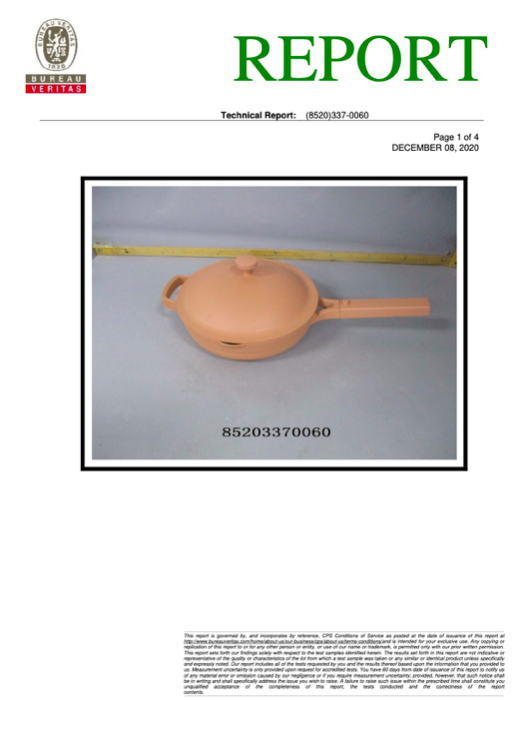
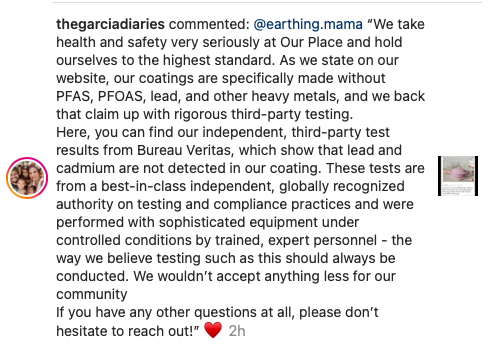
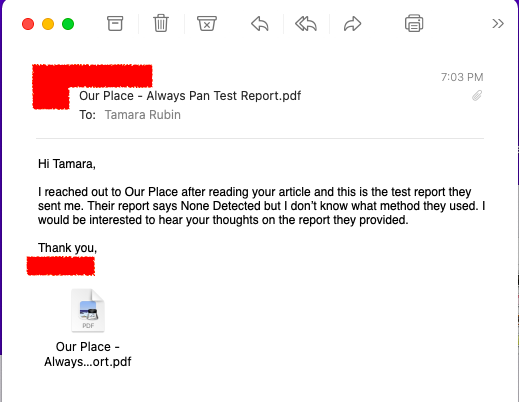
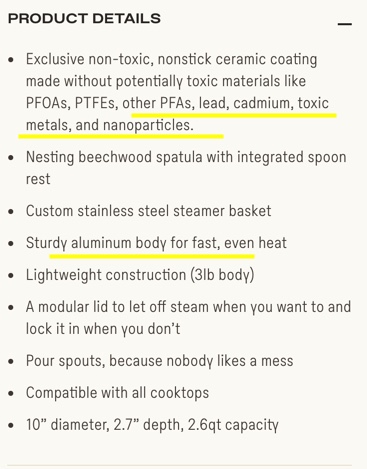 Overall consideration:
Overall consideration: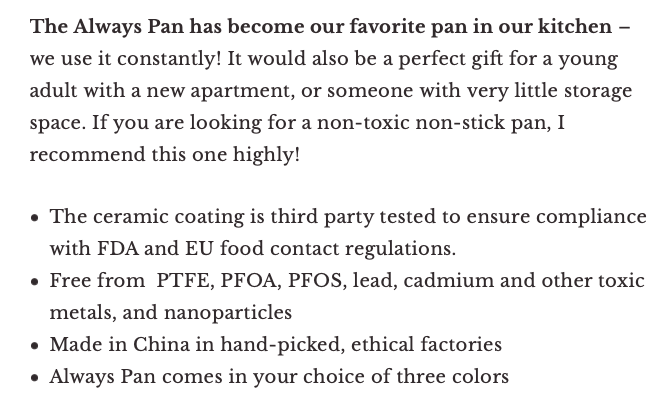
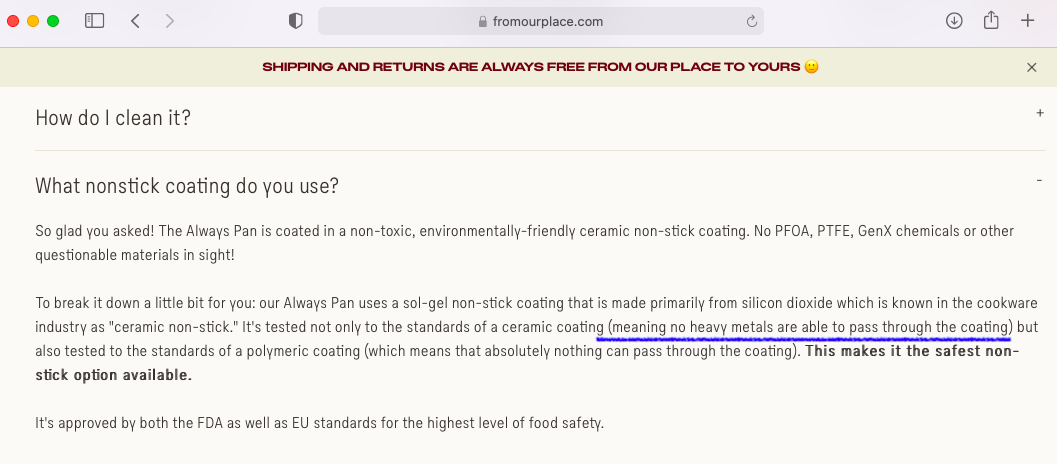

Hi Tamara, would the testing you did show the results for both the coating AND the substrate underneath? I think I recall you saying that XRF can detect metals that are underneath a coating. I recall the cooking surface was positive for lead below 90 ppm, so is it still safe by all existing regulations?
Hi Lachlan, my original post discusses this.
I’ve never had a non-stick pan that didn’t get at least a tiny scratch or nick within the first months — even when no one but me was allowed to touch it! I had one “ceramic” pan get nicked when the plastic soap dispenser fell into it. So what’s UNDERNEATH the coating is extremely important to me!
Childhood Lead Exposure, Adult Personality, and Later-Life Mental Health (2019, 2 minutes)
https://edhub.ama-assn.org/jn-learning/video-player/17844517
This JAMA Medical News video summarizes findings from a recent cohort study reporting an association between childhood lead exposure in Dunedin, New Zealand, and adult personality traits and psychopathology.
Given that lead poisoning is s a manufactured mental illness how do you expect a company to offer a sane assessment of their products?
I love you Kenneth! I cannot remember – did we meet in person at a conference in 2008 or something? Or have we never met in person?! I would love to meet you in person sometime – eventually – post pandemic!
Thank you for always having the most amazing comments!
Tamara
I love you too, Tamara! We have never met IRL.
The latest installment in the Manufactured Mental Illness series will arrive June 2021. Here’s the preview:
https://psycnet.apa.org/doiLanding?doi=10.1037%2Fpne0000225
APA PsycArticles: Journal Article
Low-level lead exposure impairs fronto-executive functions: A call to update the DSM–5 with lead poisoning as a neurodevelopmental disorder.
Neuwirth, L. S., Lopez, O. E., Schneider, J. S., & Markowitz, M. E. (2020). Low-level lead exposure impairs fronto-executive functions: A call to update the DSM–5 with lead poisoning as a neurodevelopmental disorder. Psychology & Neuroscience, 13(3), 299–325. https://doi.org/10.1037/pne0000225
Lead (Pb2+) exposure continues to occur despite efforts to reduce its environmental sources and affects millions of children in the United States alone. Finding Pb2+ in blood samples indicates that exposure has resulted in absorption with the potential for distribution to all cells in the body. Research conducted during the past 2 decades and summarized here has demonstrated that the brain is a critical target organ for detrimental Pb2+ effects, especially causing fronto-executive dysfunctions. This review summarizes the evidence supporting this last statement and, based on this evidence, argues that Pb2+ poisoning should be considered part of the neurodevelopmental disorder classifications within the fifth edition of the Diagnostic and Statistical Manual of Mental Disorders (DSM–5) developed by the American Psychiatric Association. Inclusion in the DSM–5 or future revisions would have impact for diagnosis acceptance and subsequent availability of resources for interventions and research. (PsycInfo Database Record (c) 2020 APA, all rights reserved)
Impact Statement
Public Significance Statement—The fifth edition of the Diagnostic and Statistical Manual of Mental Disorders (DSM–5) has yet to recognize childhood lead (Pb2+) poisoning as an early neurodevelopmental disorder that causes brain damage, with particular vulnerability to regions that regulate fronto-executive functions. Over the past two decades, ample evidence has been reported in both animal and human studies that neurodevelopmental Pb2+ exposure, even at low levels (i.e., ≤5 μg/dl), causes brain damage accompanied by persistent lifelong fronto-executive dysfunctions. The current literature review describes these findings and presents an argument for the American Psychiatric Association to recognize and include childhood Pb2+ poisoning as a formal psychological/psychiatric diagnosis within the neurodevelopmental disorder classifications. (PsycInfo Database Record (c) 2020 APA, all rights reserved)
My wife Elisabeth and I own a fancy All-Clad pan and, for the life of us, we can t remember how it ended up in our kitchen. As far as we re concerned, it just appeared there one day. Did one of us inherit it from an ex? Did I steal it from my mom? (Hi, Mom!) Seriously, no idea.
I like the fancy copper-core All Clad stainless (uncoated!)
T
Tamara, This is so typical of products coming from China but Americans are responsible for buying cheap so we’ve put most American manufacturers out of business. I got burned a few times at the beginning of the pandemic with the most notable item, thermometers bought on Amazon (they let us down too) that took 4+ months so I’d already bought them locally, taking whatever Walgreens got in that week. Without UL testing, I smashed them with a hammer … lesson learned.
This reminds me of research I did on building materials. It took several weeks to get the reports which were bare bones & therefore I didn’t trust them. It made me back off recommending products from overseas unless they came from established vendors like Home Depot … or were made in the USA.
Hi Tamara,
Just checked, the FAQ page has stated that “no heavy metals are able to pass through the coating” way earlier than you had posted your results – that statement was there in August when I checked. So it has not been added in response to your recent posts.
Oh thanks for checking that out. Interesting either way. Interesting that they are asserting “metals free” but also that “no metals can pass through” – if that’s the case (if it was from as long ago as August – then perhaps they knew about the Lead contamination in their aluminum substrate? Thank you for commenting!
tamara
I’m so tired of the sheisty way these companies try to skirt the toxic metals issue. They always start by saying how concerned they are. Then starts the gaslighting. It’s the same format.